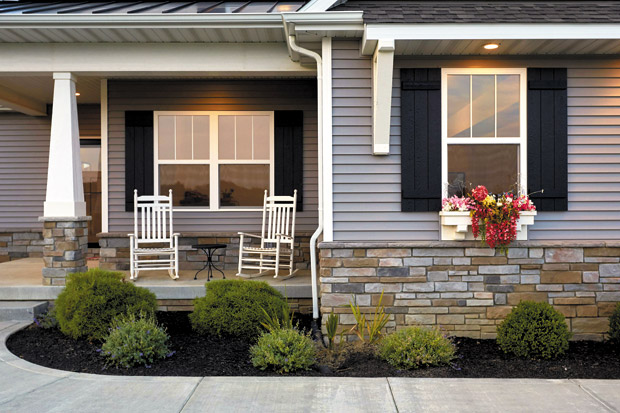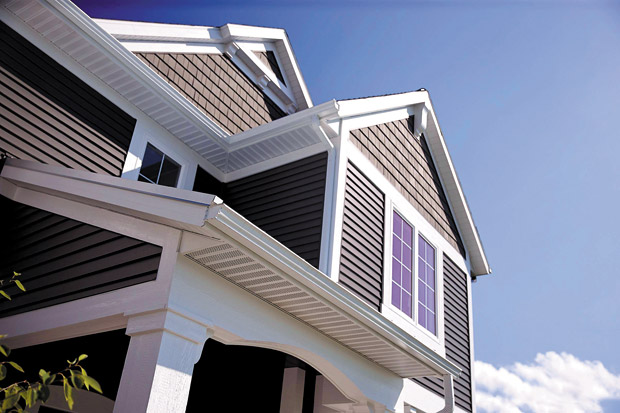Hot home design tips for siding
Selecting new siding is one of the most important curb appeal decisions homeowners face when building new or remodeling an existing home.
Many manufacturers are now combining traditional styles and materials with advanced technologies, delivering a product that homeowners can love for years to come. Among all the options on the market, vinyl siding, with its various styles, textures and colors, remains the most-used product. In fact, 2016 marked 22 straight years that vinyl siding held the top spot in cladding for new single-family houses, according to the U.S. Census Bureau’s annual home report. This material has come a long way since 1950s, with manufacturers, like Ply Gem
Building Products, making strides in research and development efforts for design and performance.
Whether you are building a new home or remodeling, there are four key considerations every homeowner should account for when determining which siding option will best meet his or her needs.
Durability
Siding selection is typically an once-in-a-lifetime decision, making durability a key factor for many. Homeowners should look for a siding option that is resistant to every element, including rain, wind and even the sun. Manufacturers now offer siding products with technologies that resist the damaging impact of the sun, preserving color for the lifetime of the home. Options, like Ply Gem’s Mastic Vinyl Siding SolarDefense Reflective Technology, expand exterior home design with darker, on-trend colors that can make your home the envy of the neighborhood.
Design and color
Today, the most overwhelming decision for many when considering siding options can be style and color, but it doesn’t need to be. There are several primary siding material options available to homeowners — vinyl, aluminum, steel, wood, brick, fiber cement, stucco and stone — and countless color and style options within each material type. To help you determine what will look best, seek the advice of a siding specialist like a contractor, builder or architect. They can educate you on color coordination and what would go well with the neighborhood, while still giving personalized options for your home. Also check out online resources like Ply Gem’s home exterior visualizer to experiment and customize your style.
“In recent years, homeowners have been getting more creative and choosing bolder colorful options for their exterior,” said Pat Verlodt, president of Color Services & Associates, an organization that identifies color trends and educates consumers and manufacturers about those trends. “Whether you’re looking for a certain period-specific color scheme to align with historical significance, for a new palette to freshen up your curb appeal, or for a specific panel texture, such as cedar shake or wood clapboard, my recommendation is to look at vinyl. It provides the homeowner the freedom to add low-maintenance color and definition that will never go out of style or need painting or refinishing.”
In fact, more than 400 vinyl siding colors have been certified for color retention, according to the Vinyl Siding Institute. The variety offers homeowners an endless palette of fade-resistant colors, from pastels to deep hues, combined with trim, accents and accessories.
Maintenance
Beyond style and color, homeowners are also seeking siding that is low maintenance to reduce or eliminate the cost and personal time used for proper upkeep. Each type has a different level of care and maintenance. Vinyl typically requires just soap and water for periodic cleaning, and no need to paint, stain or caulk, which means little maintenance over the long term. Wood and fiber cement can require repainting every five to seven years. Stucco will need to be re-painted and sealed. Brick and stone require repointing of mortar. The earlier point about durability plays a part here in ensuring that the option you select is free from potential time-consuming and costly repairs due to storm damage.
Affordability
Lastly, establish a financial plan and budget. By doing this homework up front, you can have a more informed consultation with potential contractors and better ensure that estimates are aligned with your budget. Don’t forget that sometimes investing a little more into the project up front may reduce issues and maintenance costs later.
As you look to select new exterior siding, be sure to keep in mind these important factors to make the best choice possible for your home. To get started, look to manufacturer websites for siding choices, and home visualizer and color selection tools that help homeowners experiment with different colors and textures before making a decision.
This article is courtesy of Brandpoint.

